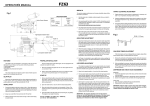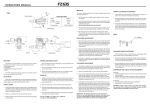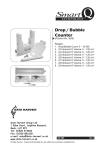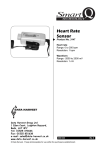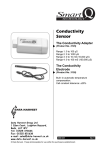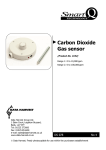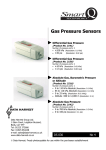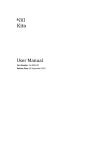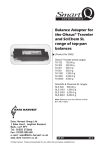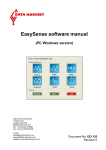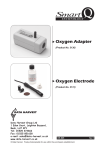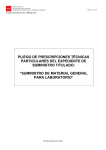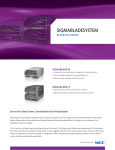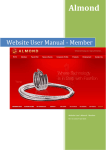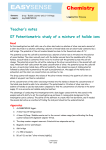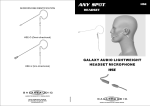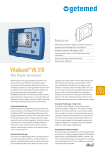Download Vu Heart Rate Sensor
Transcript
DS127 (1) Vu Heart rate Sensor • Heart rate Range: 0 to 200 bpm Resolution: 1 bpm • Waveform Range: -2,000 to 2,000 mV Resolution: ±4 mV Product No. 2327 The Heart Rate sensor sensing clip (pleth) holds an infrared LED that shines a light through either a finger or ear lobe onto a light sensitive detector. As the amount of light transmitted varies with the flow of blood, the sensor can record either blood flow (heart waveform), or heart rate (beats per minute). Note: This sensor is only suitable for use with the Vu data logger. Connecting • Push one end of a Vu sensor cable into the shaped socket on the sensor’s housing and the other end to an input socket on Vu. • Insert the jack plug from the finger/ear lobe clip into the jack socket of the of the sensor housing. • Vu will detect that the Heart rate sensor is connected and display values using the currently selected range. Measurement procedure Note: This sensor works best if the test subject keeps the finger with the sensing clip still. Infrared LED The Pleth Light Sensitive Detector (positioned on fleshy side of the finger) • Attach the sensing clip to either the fingertip or to the ear lobe. • Sit still as any muscle movements will influence the signal. The red LED on the sensor housing will start to flash in time with the heartbeat - wait for the signal to settle (approx. 10 seconds). If the clip is attached to the finger you may feel a throbbing sensation. • Once a regular heart rate is detected, begin recording data. To change the range The Heart rate sensor can record either Heart rate in beats per minute (bpm) or Heart waveform (mV). To change the range on Vu: • Use the buttons to scroll to Meter and press . 1 © Data Harvest. Freely photocopiable for use within the purchasers establishment • Press • With the cursor pointing at Set range press . Scroll so the cursor is pointing to Heart Monitor and press ▼ The cursor will indicate the range currently selected. Use the buttons to scroll the list until the cursor is pointing at the required to select. range. Press • Press to return to the sensor window, then . ► Waveform Beats / min to return to Meters window. The range setting is retained by Vu and will be applied to any Heart rate sensor that is connected to the logger until changed by the user. It is also possible to change the range from within the EasySense software. For instructions please refer to the software user’s manual. Requirements For Vu to recognise this sensor your logger must have V1.1 or higher firmware. To find Vu’s firmware version carry out a hard reset (press + + at the same time for a second and then release). The LCD will display EasySense Vu and its firmware version number before returning to the main menu. For full features (e.g. pictogram using heart picture) use with V3.2 or higher of the EasySense software. Upgrades are available from Downloads on the Data Harvest website (www.data-harvest.co.uk). Practical information The amount of light that can be detected by the Light Sensitive Detector (LSD) will vary with each test subject and as to whether the clip is attached to a fingertip or ear lobe. When attached to a finger: • Position the finger lobe clip so that the LSD is on the fleshy side of the finger. • Nail varnish may block infrared and so affect readings. • Values should not be affected by skin colouring. LSD • Some subjects may have poor peripheral circulation (the extent to which the blood vessels in the fingertip are filled with blood), in which case use the earlobe or select another subject. • If the heart rate does not seem to settle, try warming the hands by rubbing to increase the blood flow. • If readings are lower than expected, try repositioning the clip to make sure contact is obtained. Attached to an ear lobe: • Remove any earrings before attaching the finger/ear lobe clip to the ear lobe. • The clip can be made more secure by attaching the slide on the lead to the subject’s clothing. • If the heart rate does not settle or if readings are lower than expected, try repositioning the clip. Each time the finger/ear lobe clip is attached to a fingertip or ear lobe, wait until the signal stabilises before starting to record data - the initial unstable signal will be due to compression from the clip being attached. Stay still while recording data. Movement e.g. raising and lowering a hand, will change blood flow in the finger and give erratic readings. 2 If the finger/earlobe clip ‘loses contact’ with the pulse, the reading may momentarily drop to zero. Contact lost Communication re-established The light sensitive detector (LSD) in the clip can be sensitive to high levels of ambient infrared light e.g. bright sun or room lights. If the light interferes with the detector the Sensor may ‘lose contact’. Stop logging, and reduce the light level e.g. by covering the sensor clip before starting to log again. Note: If you alter the light level while logging the sensor will need to adjust to the new conditions. Avoid applying pressure to the sensor clip e.g. by resting the finger clip on a work surface. It is possible to alter heart rate by changing breathing. Encourage the test subject to breath normally. This Sensor is not intended for medical diagnosis. Do not be alarmed if results do not correspond to quote numbers, these represent typical averages. It is quite normal for the heart to occasionally miss a beat. Example of the depth of dicrotic notch that may affect Heart rate data. It is possible for the dicrotic notch to be recorded as a separate pulse, and so give higher readings than expected. The effects are usually more noticeable if the clip is attached to the finger; try using with the clip attached to the ear lobe. Dicrotic notch This sensor is not waterproof. Clean the clip by wiping with a cloth that has been rinsed in disinfectant. Background The Heart rate sensor is used to measure the pulse that is found throughout the human body. This pulse will result in a change in the volume of arterial blood with each pulse beat. This change in blood volume can be detected in the fingertip or ear lobe using a technique called Photoplethysmography. The device that detects the signal is called a plethysmograph (or ‘pleth’ for short). 3 The pleth consists of: • An infrared LED which illuminates the tissue and • A light sensitive detector (LSD), which detects the amount of light transmitted from the tissue. The infrared LED and the light sensitive detector (LSD) are mounted in a spring-loaded device that can be clipped onto the fingertip or ear lobe. Infrared LED Finger Vascular Bed Light Sensitive Detector Infrared light is absorbed well in blood and weakly in tissue. Any changes in blood volume will be registered since increasing (or decreasing) volume will cause more or less light absorption. Heart rate (beats per minute) Heart rate is a direct measure of how many times your heart contracts to pump blood to your body in a minute. A child has a smaller heart and therefore their heart needs to beat faster in order to pump the proper amount of blood. Heart rate can vary with age as shown below: Age Average heart rate (beats per minute) Newborn 140 7 years 85 – 90 14 years 80 – 85 Adult 70 – 80 In normal healthy individuals the heart rate, and thus the pulse rate, varies with the body's need to absorb oxygen and excrete carbon dioxide. When you exercise or feel anxious your heart beats more quickly, increasing the flow of oxygenated blood to your muscles. It may also be increased by stress, adrenaline entering the bloodstream or with an increase in temperature caused by fever. The heart rate decreases when asleep and some medical conditions may also cause a drop. Irregular changes in heart rate occur in all people. Following exercise it takes a while for the heart rate to return to resting level. This is the recovery time and gives an indication of the fitness of the individual. Recovery time may vary from less than five minute in very fit individuals to around 15 minutes. Safe Pulse rates During experiments the safe heart rate should not be exceeded. The safe level is given as the maximum heart rate for age, minus 20 beats per minute. Age 7&8 9 & 10 11 12 & 13 Maximum heart rate 210 – (0.65 x age) 205 204 203 202 4 Safe heart rate Max. heart rate - 20 185 184 183 182 It is important that investigations do not become a competition. Consider any possible health problems before selecting the subject. Heart Waveform (mV) The heartbeat recorded by the Heart rate sensor is a measure of volume of blood in the finger or earlobe against time. The waveform is the shape of the wave as it travels. For a healthy adult at rest, the heart beats on average at about 60 beats per minute or one a second i.e. around 1 Hz. This frequency is not constant (even in a healthy individual at rest). It takes approximately one second to record a complete wave, so it is usually best to select a short total recording time. A shorter interval will normally show more detail. For example: User Level 1, 2 or 3 1, 2 or 3 2 or 3 2 or 3 2 or 3 3 3 EasyLog EasyLog Graph Graph Graph Scope Scope Total time 5s 10 s 2s 5s 10 s 5.1 s 12.75 s Interval 30 ms 30 ms 20 ms 20 ms 20 ms 20 ms 50 ms No. of samples Approx. no. of heart waves 166 333 100 250 500 256 256 7-9 15 -17 2-3 5-6 10 - 12 10 20 Recording mode Note: With Vu the fastest speed that can be used to capture data is 50 Hz (20 ms). Primary investigations 1. 2. Heart rate changes due to activity Recovery rate - after exercise pulse is timed until it gets back to the normal standing heart rate. Individuals with low recovery times exhibit better aerobic fitness. • • • 3. 4. 5. Record your heart rate while at rest. Either (a) remain seated and tap your feet in place to simulate a run or (b) remove the sensor clip, exercise vigorously then reconnect the clip. Record the heart rate change due to this activity. To find your recovery rate continue recording data until your heart rate returns to its resting heart rate level. Investigating pulse rate with different body positions (sitting, crouching, standing, lying down). Effect of food (chocolate) or mild stimulants (caffeine) Effect of music on pulse rate E.g. Vu eBook worksheets such as How does exercise change us? Pulses, what is normal? Pulse, who is fit! 5 Warranty All Data Harvest Sensors are warranted to be free from defects in materials and workmanship for a period of 12 months from the date of purchase provided they have been used in accordance with any instructions, under normal laboratory conditions. This warranty does not apply if the Sensor has been damaged by accident or misuse. In the event of a fault developing within the 12 month period, the Sensor must be returned to Data Harvest for repair or replacement at no expense to the user other than postal charges. Note: Data Harvest products are designed for educational use and are not intended for use in industrial, medical or commercial applications. WEEE (Waste Electrical and Electronic Equipment) Legislation Data Harvest Group Ltd is fully compliant with WEEE legislation and is pleased to provide a disposal service for any of our products when their life expires. Simply return them to us clearly identified as ‘life expired’ and we will dispose of them for you. 6






